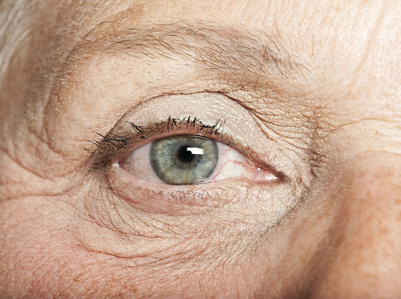Age-related macular degeneration (AMD) is a disease that affects the macula, a small but essential part of the retina responsible for central vision. AMD is common among the elderly, with approximately 1.3 million French individuals affected, most of whom are over 50 years old. It is a leading cause of visual impairment, as it can gradually destroy the central part of the eye's retina.

Types of AMD:
Two primary forms of AMD are recognized: the wet form, which progresses rapidly, and the dry form, which advances more gradually but can still cause significant damage. While treatments exist for the wet form, currently, there is no effective treatment for the dry form, impacting the daily lives of 800,000 individuals. Research is underway to evaluate molecules that may prevent the premature death of retinal cells, offering hope for future treatments.
Symptoms of AMD:
Find YOUR ideal care home NOW!
AMD can lead to challenges in reading, watching television, and driving as it affects central vision. However, peripheral vision remains unaffected, allowing individuals to maintain some level of independence in activities like dressing and eating.
Causes and risk factors:
Age is the primary risk factor for AMD, with the likelihood of developing it increasing with age. Other factors include smoking, obesity, a history of cataract surgery, a family history of AMD, and being female.
Prevention of AMD:
Preventing AMD involves several key strategies:
- Regular eye check-ups: Starting from age 50, regular eye exams are essential to detect any signs of AMD.
- Avoiding smoking: Quitting smoking significantly reduces the risk of developing AMD.
- Balanced diet: Consuming foods rich in Omega-3 fatty acids and low in lipids can help reduce the risk of AMD.
- Controlling other risk factors: Managing factors like obesity and maintaining a healthy lifestyle is crucial.
Diagnosing and treating AMD:
Early diagnosis and treatment are vital for preserving vision. Consultation with an ophthalmologist is recommended as soon as symptoms or vision changes occur. Diagnosis involves various eye examinations to detect abnormalities, followed by appropriate treatment options:
- Visual rehabilitation: Maximizing remaining vision through rehabilitation programs.
- Medication injections: Injections to block the development of harmful blood vessels in wet AMD.
- Photodynamic therapy (PDT): Destroying abnormal blood vessels in some cases of AMD.
- Nutritional supplements: Certain supplements can help slow the progression of the disease.
- Optical magnification devices: Assistive devices like magnifying glasses for severe vision impairment.
AMD Risk Factors and Prevention Strategies
| Risk Factors | Prevention Strategies |
|---|---|
| Age (50+ years at higher risk) | Regular eye check-ups: Annual exams to detect early signs of AMD |
| Smoking (doubles the risk) | Avoid smoking: Quitting significantly lowers the likelihood of developing AMD |
| Obesity (linked to AMD progression) | Maintain a healthy weight: Balanced diet and exercise help reduce risks |
| Poor diet (low in Omega-3, high in saturated fats) | Healthy diet: Eat leafy greens, Omega-3 rich fish, and nuts |
| Family history (genetic predisposition) | Early monitoring: Those with a family history should have regular eye exams |
| Gender (women at higher risk) | Monitor changes: Women should be extra vigilant about vision changes |
Early diagnosis and prompt treatment are essential for managing AMD effectively. While treatments exist for the wet form, ongoing research offers hope for future treatments for the dry form. Consultation with an ophthalmologist is recommended for personalized evaluation and treatment.
FAQ: Understanding and Managing AMD
What is AMD?
Age-Related Macular Degeneration (AMD) is an eye disease that affects central vision, making activities like reading and recognizing faces difficult.
What are the symptoms of AMD?
Early signs include blurry vision, difficulty seeing fine details, and dark or distorted spots in central vision.
Who is at risk for AMD?
People over 50, smokers, individuals with obesity, and those with a family history of AMD are at higher risk.
Can AMD be cured?
There is no cure, but treatments for wet AMD can slow progression. Research is ongoing for dry AMD treatments.
What treatments are available for wet AMD?
Anti-VEGF injections, laser therapy, and photodynamic therapy (PDT) help slow abnormal blood vessel growth.
How can I slow down the progression of AMD?
Eating a diet rich in Omega-3s, avoiding smoking, wearing UV-protective sunglasses, and regular eye exams can help.
What are the differences between dry and wet AMD?
Dry AMD progresses slowly with retinal thinning, while wet AMD progresses rapidly due to abnormal blood vessel growth.
Can AMD lead to complete blindness?
No, AMD primarily affects central vision, but peripheral vision remains intact, allowing some independence.
Are there assistive devices for AMD patients?
Yes, optical magnification devices, large-print books, and special screen readers can help individuals with AMD.
Where can I find support for AMD care?
Our advisors at Senior Home Plus can help you find specialized care facilities. Contact us at 0230 608 0055 or fill out our online form for assistance.
Need help finding a care home?
Senior Home Plus offers free personalized guidance to help you find a care facility that suits your health needs, budget, and preferred location in the UK.
Call us at 0203 608 0055 to get expert assistance today.
Do you need a care home for yourself or your loved one?
Search for Care Homes by Region in the UK
| East Midlands | Eastern | Isle of Man |
| London | North East | North West |
| Northern Ireland | Scotland | South East |
| South West | Wales | West Midlands |
| Yorkshire and the Humber |

